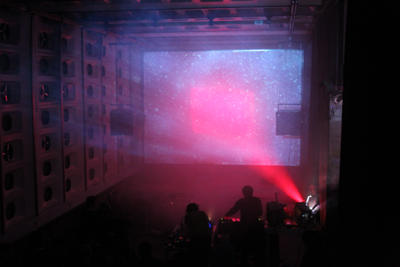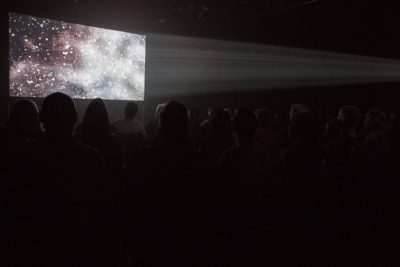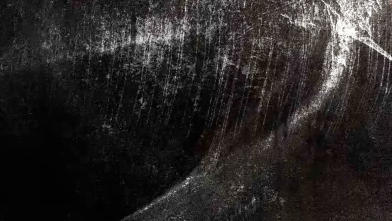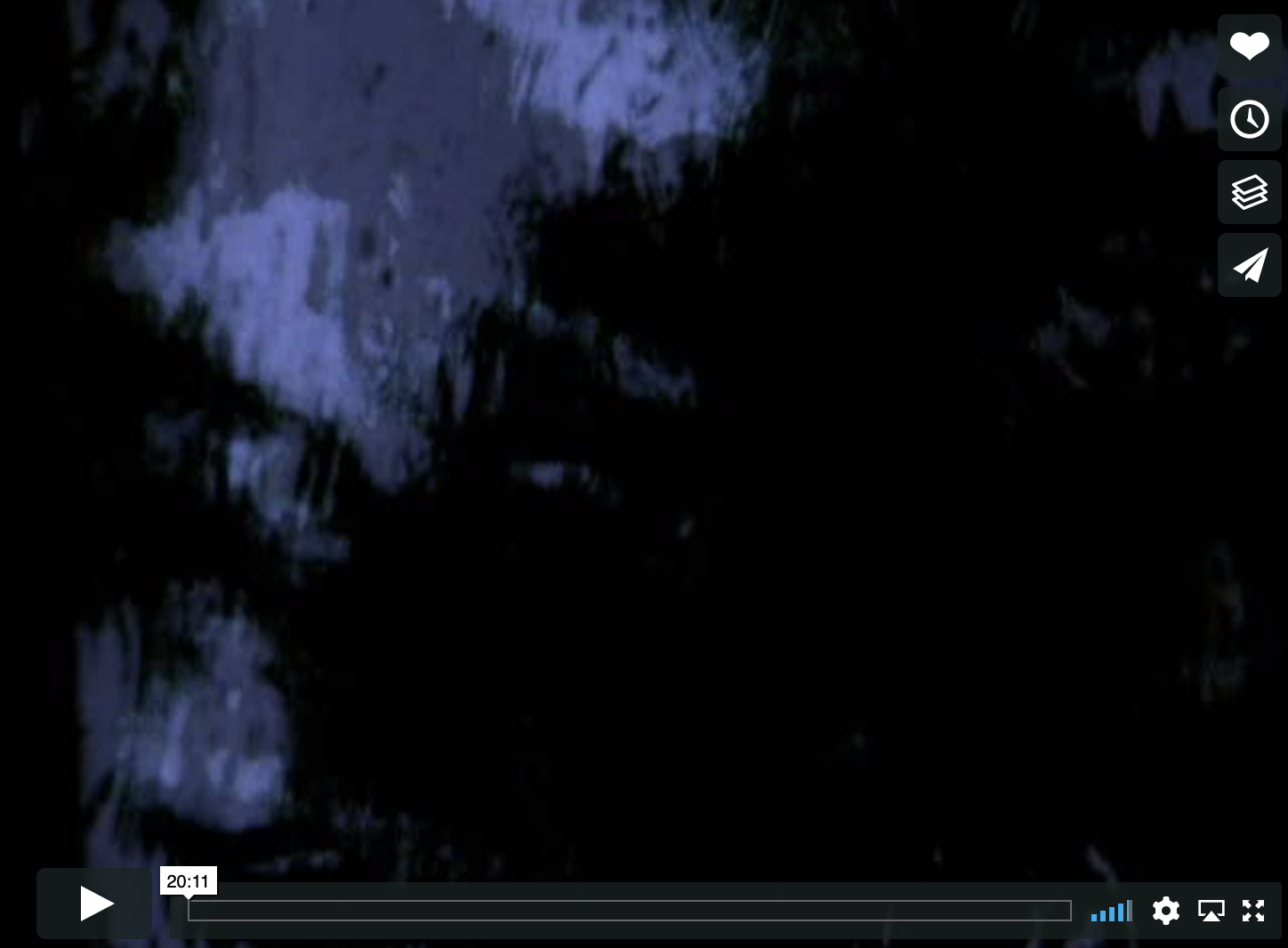
‘For nearly two decades, Japanese filmmaker Takashi Makino has been making entirely abstract films. For him, it seems, abstraction is less of an aesthetic mode and more of a philosophy, a way of creating a space for the viewer to engage with his sonic-visual material as they see fit, Some viewers may choose to actively participate in reading and shaping the meaning of the images he presents, while others will be more interested in passively receiving them and enjoying them on a sensorial or emotional level. What is important, is that in either case, the viewer feels involved.
‘As he writes on his website, “what fascinates me most about film expression is the potential for what is presented on the screen to collide with each individual viewer’s emotional landscape, and the new ‘image’ created inside the viewer’s mind resulting from this collision.” For Makino, abstraction offers a space for imagination, free from the limitation posed by direct representation, free from the imposition of applied or linear meaning. Abstraction offers freedom, and once experienced, freedom is hard to give up.
‘Most of his many films assume a somewhat similar form. He collects a mass of recorded material that he shoots himself—its origin kept a secret that only he and his collaborators are allowed in on, as is what he was thinking about when shooting it, what it might mean—and then edits its together, layering masses upon masses of individual images together to make a new plane of abstract “hybrid images.” He then adds an accompanying soundtrack, provided by a musician (Jim O’Rourke, Cal Lyall, or Carl Stone, for instance) or that he produces himself. The films are usually densely textured, colorful, and complex in appearance—big, dramatic cinematic canvases that have a real sense of scale and grandeur.
‘Since 2012 (2013)—in which a mix of celluloid and digital film sources are blended into a stormy, scratchy canvas that dilates alongside a dense drone—he has been experimenting with performance, and from Space Noise 3D (2014), with expanded elements too, using 3D glasses with one lens cut out to change the effects that his film produce, and the experience the audience has. Though each work is fundamentally similar, he continues to find ways to experiment and to further expand upon the ways the films are produced and presented.
‘In a Q&A at a screening some years back, he explained his style succinctly. “Most filmmakers make cinema with one or two layers,” he said, before pausing then laughing. “I am making one thousand layer cinema.” While avoiding revealing too many of his secrets—like any self-respecting magician of moving images should—in the below interview Makino explains some of what goes into making “one thousand layer cinema,” focusing on his latest work, Memento Stella. Having premiered it as a film at International Film Festival Rotterdam in January, he is now traveling the world with it, presenting the work in the form of a performance, most recently at Sheffield Doc/Fest and Filmadrid.’ — Matt Turner
____
Stills


































____
Further
Takashi Makino @ IMDb
Takashi Makino @ Lightcone
Makino Takashi @ Experimental Cinema
“I HAVE A BIG INTEREST FOR THE IMAGE OF DREAMS AND IMAGINATION”
DVD: Makino Takashi Film Works Vol. 1 With Jim O’Rourke
Makino Takashi: Entering a Noisy Cosmos
TAKASHI MAKINO / INTERVIEW
TAKASHI MAKINO – THIS LONG CENTURY
Le cinéma comme art abstrait : Takashi Makino
Hallucinatory and experiential, Takashi creates abstract cinematic worlds
My film looks like something very noisy and abstract, but actually, everything in it comes from our own world
Interview: Takashi Makino @ Film Comment
I saw a green horizon in the dark
Guest in Focus: Takashi Makino
Takashi Makino’s 2012 by Marianne Shaneen
LA REINCARNAZIONE DI STAN BRAKHAGE NEL CINEMA DI TAKASHI MAKINO
VIS SPOTLIGHT FEATURE: TAKASHI MAKINO
____
Extras
TOWARD THE TACTILE VISIONS Trailer
Entrevista Takashi Makino
Workshop_for Hallucination and documenta 14
_____
Interview
from MUBI

NOTEBOOK: Maybe you could start by describing how you go about making a film in general, and how what you do results in what we see?
TAKASHI MAKINO: I’ve made around 40 short films before. Memento Stella is the longest one. Each time I have an idea, or a background story, and then make an abstract film from it. My main purpose with filmmaking is to create a situation in which the audience and my film can collaborate with each other, and find a space for imagination. This is why I take an abstract approach every time. For me, abstraction is a very creative format to take, as you can see many different things within one single screen. I like facilitating this creative relationship between the viewer and the screen.
Up to around 2004, I only used celluloid materials, 16mm film and Super 8, but after that I used both of those, as well as digital materials.
NOTEBOOK: Why did you change?
MAKINO: I studied film in University in Japan, but I had no knowledge about video. In 2002, I started working for a company, the oldest Japanese development lab and post-production house. I was part of the first team that was using the HD telecine machine. Working there, I realized that I could use both materials, and that by fusing analogue film with digital video, I could make more work, and better work. When I used only film, I was experiencing technical limitations. If I wanted to shoot something over 100 times, with film, it just doesn’t work. But if I shot on film and edited digitally, I could do almost anything.
For me understanding this was very useful.
After 2015, I switched to a completely digital process. I could try many more things and experiment further. Recently, I’ve been interested in utilizing more lens work, and not just the camera’s sensor. By doing this I think I can make more creative, softer images, images that resemble film but that are achieved by using a completely digital toolset.
NOTEBOOK: Do you feel like you are trying to get back to the feel of celluloid film then, when you say about trying to recreate the look or the texture?
MAKINO: I really like the material—and the materiality—of film, but I feel if we use completely digital equipment, it will improve our knowledge of the gear. If you use a 4K sensor, and a flat GoPro lens, for instance, you can achieve a high resolution while countering the flatness of the digital image, and create something much more interesting. I like to make images that have a rich depth to them, and I think that lens work has been very helpful for achieving this: a richer depth, and a richer contrast.
NOTEBOOK: Within that, a rich image means more things for the viewer to find maybe. You touched on this a bit before, but is the viewer’s perception something that you are interested in exploring, how people see things differently? I’ve been watching Rainer Kohlberger’s films recently, and he is very interested in this, how his audience sees his work in different ways. I was wondering whether it was something you had in common?
MAKINO: His work is very hallucinatory. Our work is similar visually, but the biggest difference is that he creates every image with a computer. Even his computer he made completely by himself. All of my images come from the real world. They’re organic captures. But both of our images sometimes look similar, so we have an interest in each other.
NOTEBOOK: Related to this, I wanted to ask about your collaborations. Sometimes you work with a musician, such as Jim O’Rourke, and sometimes you make the music yourself. What decides this, and when you collaborate how does the relationship between image and sound come together?
MAKINO: Every time I make the image first. After I’ve completed the image, I start thinking about music. If I feel like I can make the right music myself, I do that. But If I think it’s going to be too difficult and I can’t make a soundtrack for the film, I start thinking about who might be the right person for the project. I’ve collaborated with Jim O’Rourke many times, eight times in fact. His soundtracks are very creative, because he doesn’t just follow the images. Sometimes he ignores the images entirely, which creates a different dynamism altogether.
When I collaborate with a musician, I always explain everything about the film. I tell them all the details behind my thinking, what images I’ve recorded, and why I’ve made the film. Sometimes I write a graphic score for them also. But I ask them to not just follow the image, because that’s not so interesting. I want a relationship, not just a soundtrack.
The other reason I collaborate with musicians is that I need a new view on my images. When I’m editing I’ve seen everything several hundred times, and everything is repeating and repeating, and I start to hear the sound in my head. I really enjoy the moment when I receive the soundtrack, to see if it matches with my expectation or not. Sometimes I don’t accept their vision at first, but I like having something I can’t control, and after watching my images with their sound several times, I usually see what they are thinking, and remember that I have to trust them or it won’t work.
NOTEBOOK: Do you ever worry that the music might affect the mood of the viewer too much? Music can be very emotionally manipulative, and with abstract imagery, it could influence the tone.
MAKINO: Recently, I haven’t made this mistake. I used to make it often though. It was very difficult to explain my feelings about the films, and this clear communication of the idea is key. If I ask them to make a super strong sound, and they make a really heavy soundtrack, the supplied file can’t be played in a cinema. Sound-mixing for film soundtracks is completely different than for normal music. I always check if the musician I’m working has experience making soundtracks, and If I work with someone who hasn’t had experience mixing soundtracks, I use a sound engineer.
NOTEBOOK: I wanted to ask about your performance-based work. You’ve also made a 3D film. What do these extra elements bring to your work, and what is it like to share the space with the people that are viewing your images?
MAKINO: For 2012 and also Space Noise, I used the Pulfrich effect. This way of making a 3D effect is very creative because it doesn’t happen in front of our eyes, but in our brain. That effect is almost 100 years old, discovered in Munich by a physicist called Carl Pulfrich. Each frame of my film has a different shape, and it’s also changing very quickly because I had to make it at 30 frames per second, because at 22, 24 or 25, it’s too slow. I tried the Pulfrich effect on it, and I found that if you hide one eye, the image turns to one side, but if you cover the other eye, it turns the other way. Each viewer can select how to watch my work, left eye, right eye, or without the glasses at all. This way, everyone can see several different films from a single screen.
NOTEBOOK: Would you make a film in virtual reality?
MAKINO: Yeah, I tried once. A 360 VR film, but the resolution wasn’t high enough for my work. Resolution is very important to me. It affects the canvas. If the canvas is large I can do many things, but if it’s smaller, I’m much more limited. I was told I could do a 4K VR image, but when I tried it, you can only see a portion of the 4K image, which isn’t the same. The resolution was too poor, and the frame rate wasn’t high enough, so I stopped making it.
NOTEBOOK: Maybe if the technology improves, Space Noise VR could still happen?
MAKINO: I like seeing my work in the cinema. Surround sound helps you to feel the depth of the space, and I like the sense of freedom the room has. VR is like a prison from which you cannot escape. I don’t know the future, but it’s not right for me at the moment.
NOTEBOOK: Do you feel like there is anything specifically Japanese about your work?
MAKINO: Rei [Hayama, Takashi Makino’s partner, and an artist and filmmaker also screening in Sheffield’s New/Japan strand] and I often talk about this. I am Japanese and I live in Japan. I cannot escape from myself. My purpose with filmmaking is that I want to make art which can go beyond borders and beyond races, countries and languages. I think that art can do that. I make films for this reason. I don’t care about “Japanese-ness” as such, however I think that my work is very strict, and sometimes too long, and I am often thinking about what it means to receive so much information at once. When we are overwhelmed by an abundance of information we turn towards nothing. All of these things are very Japanese.
NOTEBOOK: When somebody watches your films, do you want them to try to think about them, and try to work out what it means and what is happening? Or are you happy for them to be less active, and just let themselves be hit by the images, and have more of an immersive experience perhaps?
MAKINO: I don’t want to say anything specific to the audience. If I say something strongly, it is too much. Every way is okay for me.
____________
9 of Takashi Makino’s 23 films
____________
No is E (2006)
‘With the aid of a layered construction of the image, Makino has managed to capture the different reflections of light on the surface of water. The acoustic-noise-like music and the dancing particles of light move like swarms of microorganisms and in this way slowly cover the entire screen. With No is E, Makino won the Shuji Terayama Prize at the Image Forum Festival 2007 in Japan.’ — 25 FPS
the entirety
____________
Tranquil (2007)
‘“The rain” and “white noise” , “the outside of water” , “the inside of water” , everything become to together and drifting. A dark dark film in rain forest inspired by a music term to “Tranquil”.’ — letterboxd

_______________
Still in Cosmos (2009)
‘I do not think that the word “chaos” means “confusion” or “disarray”, rather I believe it refers to a state in which the name or location of “objects” remains unknown. For instance, if a bird escapes from its cage, the world it discovers outside will appear to be chaos, but if it joins with a flock of other birds, it will gradually learn to apply “names” to various places – a safe place, a dangerous place, etc., thereby creating cosmos (order). When watching a film, the viewers all sit down in the same darkness and receive the same light and sound but each sees a different dream. I believe that this symbolizes a reversion to their initial state, that when they look at total chaos through newborn eyes, they give birth to a new cosmos. I sincerely hope that the violent chaos that exists in Still in Cosmos will give rise to the same number of new cosmoses as there are viewers.’ — Takashi Makino
Excerpt
_________
2012 (2013)
‘Takashi Makino’s thirty-minute film 2012 drenches the audience with sounds of prolonged resonant scraped string textures and images of shimmering blue clouds of drifting particles. Panes of swirling atoms, scratched lines, and densely patterned fields rotate and pan in different directions, inducing an expansive sensory meditation on the nature of perception.
‘Drawn into whirling eddies of what could be microscopic realms of film grain, plasma cells, or subatomic particles, I’m then transported into cosmic immensities of galaxies, nebulae. I seem endowed with new sensory abilities—am I seeing sound? Is this how an insect sees?
‘2012’s shifting planes evoke tectonic plates, archeological strata, in a cinematic and sonic reverie of not-quite-remembered dream images, of personal and collective memory spanning multiple temporalities. This disorientation grants moments of recognition: glimpses of what might be leaves, sun-dappled water, sounds of birds, children, wind—but defamiliarized, as if seen upon returning to Earth after a long sojourn.’ — Marianne Shaneen, BOMB
the entirety
______________
Space Noise 3D (2014)
‘[Space Noise] is a performance in which the double 25 FPS award winner confronts high-resolution video images and 16mm live projection. A duel between the all-dominant immaculate digital and the irregular organic material dissolves in multiple layers of chaos. Enormous quantities of light movements from film loops capture the screen in thousands of pixels of digital projection and create new images in constant change and enhancement. The sound accompanying them live only repeats and spreads the noise, developing images by whirling speed. Noise, located on the tape as a constituent part of the film, becomes the aim of Makino’s quest – Noise-Image. This quest for a new film experience intensifies with additional effects – a smoke curtain reveals the fullness of the light beams’ rainbow spectrum, while a neutral single-eye ND filter creates a three-dimensional illusion.’ — 25 FPS
Excerpt
In performance (Excerpt)
Interview with Takashi Makino (Space Noise 3D)
______________
Phantom Nebula (2014)
‘Layering 10,000 film and video images, Phantom Nebula reveals changing forms that resemble both cosmic bodies and organic matter. Makino invites the audience to contemplate the similarities between cells and stars in this immersive film and sound performance.’ — M:ST Festival
Excerpt
_____________
w/ Floris Vanhoof Labyrinth (2017)
at Les Ateliers Claus – Brussels, Belgium – 2017-05-04
Excerpt
______________
Memento Stella (2018)
‘In his latest venture Japanese artist Takashi Makino adopts a consistent process of creative intervention and adjustment in order to cleanse his shots until they become unrecognizable. Even though the images are devoid of any reference points, the piece brings to life something essential: some kind of elementary matter which gives rise to all living and non-living things – in a manner similar to Mark Rothko’s renowned black canvases. Memento Stella is a remarkable film with a compelling hallucinogenic rhythm that allows us to experience fundamental existential issues of consciousness and being. The accompanying electroacoustic soundtrack was written by Dutch avant-garde pianist Reinier van Houdt.’ — Hubert Poul
Trailer
Memento Stella Cinechamber Trailer
______________
w/ Cal Lyall Paracollider (2019)
Immersive Audiovisual Noise Spatialization Project
Excerpt
*
p.s. Hey. ** David Ehrenstein, Hi. The current mania to reject and condemn anyone who doesn’t share one’s exact opinion is ugly and deeply conservative and nothing but self-indicting, if you ask me. ** Bill, Hi, Bill. Yeah, the baby flytrap is a sleeper hit, I think. I hope you’re feeling much better by now. I don’t believe I know Shena Mackay’s novels? Huh. I will def. do an investigation. Thanks, man. ** James, Hi, sir. Oh, thanks very much for the thoughts and props. Consider them boomerangs. And thanks for thinking my little piece of advice was worth sharing. Love, me. ** Steve Erickson, Let me join the chorus that thinks your ‘Fight Club’ essay is just excellent. Kudos! Btw, I’ve forgotten … have you seen ‘The Politician’? It’s playing here, and a couple of people have highly recommended it to me. Everyone, Here’s Mr. Erickson weighing in on Ulrich Kohler’s IN MY ROOM with, warning, some spoilers. If you dare. ** Paul Curran, Hi, Paul! Yeah, Halloween makes every year mouthwatering for a short but solid amount of time. Yes, very, very sad about Nicholas. I’m still trying to process the loss, and I’m not sure I can. Excellent that you’re making writing progress! That’s the best news! And us too about Tokyo/Japan. Don’t know our dates yet, but it’s a hell or high water deal, so it’ll happen. Take care, man. ** Dominik, Hi, D! Reclusiveness is perfectly okay. Except for me, I guess, ha ha. Yes, my agent is enthusiastic about my novel, so we’re past that stage and onto the much more stressy stage of seeing what if any publishers are interested. I’ll be very glad once that phase is over. Oh, yeah, Poppy and I had a long correspondence when he (then a she) was writing ‘EC’ as he wanted to pick my brain and talk about serial killers and stuff. And I blurbed the novel in its first iteration. So, yes, I know it, and I’m down. Hooray about the SCAB instagram. Yeah, that does seem like the right platform for it. Cool! Everyone, Dominick’s great and crucial magazine SCAB has a new and very charismatic instagram page that I urge you to visit and then … ‘follow’ or ‘friend’ or whatever one does to attach oneself to an account on instagram. The pleasure galore is right here. I spied the young Daniel Johns in there in my first peek. Always an excellent choice! Lots of love to you, pal, and I hope your week provides the smoothest and most excitable sailing. ** alex rose, Hello maestro among maestros! I didn’t know that about Donatein. Ugh. Drenched psycho boy is quite possibly my first dream purchase too. I do like those frozen children too for some reason. Well, I want almost every single one of them, fuck it. Love to you too, man, in bundles. ** Sypha, Hi, James. Yes, so sad about Nicholas. Love to you. ** _Black_Acrylic, I utterly and completely agree with you, as you can well imagine. ** Right. Today the blog its given over to the fascinating Takashi Makino, who was just in the States on a short tour showing his films and doing related performances a few weeks back. Very beautiful work, if you don’t know it, and, if you don’t, now you do if you so choose. See you tomorrow.




 Now available in North America
Now available in North America 
Big D, Sad fucking news about Nick. I was in Detroit on a layover when I found out. Just texted with him in the summer. We set up a phone call, but he canceled because he was too ill. Loved that guy, I’ll miss him.
We made it safely. So far, so good. We’re going more into central London today to fuck about.
We’re going to CROWD Wednesday night.
Takashi Makino’s work is very lovely.
The “movement to condemn” you reference is taking place on a very low cultural level. For the last week or so I’ve been fending off attacks from people who insist I regrd Dave Chappelle as a comic genius and rever “Batman” movies as if they were directed by Dreyer or Bresson. Not Gonna Happen. They use the meme “Cancel Culture” to express their loathing of anyone who speaks out against these creeps and gets results. This all started when the Academy decided against making Kevin Hart the MC of the Oscar ceremonies due to the uproar caused when Hart declared he would physically assault his son if he found him playing with a doll house. Apparently there are a lot of people out there who approve of physically assaulting children for displaying any form of behavior perceived o be “gay”
Hi!!
Hey, Dennis! How are you? What’re your plans for the week?
Ah, well, I’m a little late but congratulations!!!! My fingers are still ultracrossed – I hope this stressful phase won’t last too long and your novel will find its worthy home soon!
Holy shit, for real?! I should’ve thought, haha. I mean, that you had some connection to Exquisite Corpse. I just finished it like half an hour ago and I’m sitting here and… I just want to start right over or I want it to never end. I wish so badly it was my book. Do you ever have this? When you read something and it’s just so good or maybe even just so “close” you wish you had written it? It’s a little bit like when I see a gorgeous boy and I can’t decide if I want to fuck him or be him, haha. (How strange, also, that Poppy is a trans man. I mean, that in itself isn’t strange at all, but rather the timing – that I found his book, I got completely mesmerized and then figured out we even have this in common – all in this phase of my life in which I’m more and more intensely focused on actually transitioning myself. … Now, I’m a little confused. Have we talked about this before? Beyond the artistic gender-bending and stuff?)
Thank you so much for the SCAB instagram shoutout! Young Daniel Johns – right?! I had this photo saved on my laptop for… I don’t even know, 5 years? And I never knew who he was. And now that I wanted to post it, I tried to find out and when I did… well. He definitely looked like a muse.
Are you still working on the TV series?
I hope you have a great day and week and all else! Lots of love!!
Speaking of films, I saw IT: Chapter Two not so long ago with my dad and two of my brothers. I liked it… it wasn’t quite on the same level as the first chapter but was enjoyable enough in its own right and stayed fairly true to the source material. I’m on vacation this week so I’ll probably try to get to the theaters again… I want to see THE JOKER at some point but my brothers and I plan to wait a few weeks for the hype to die down. Maybe I’ll catch JUDY.
Don’t really have much other plans for this week. Might do a bit of work on the 50th Mauve Zone Recordings release, which will be a new Sypha Nadon album. Maybe watch a few movies at home. Get my annual flu shot. Stuff like that. You know me, I live on the edge…
Thanks, Dennis! Stoked to hear you like the work. I agree that that first painting is the most successful. It feels like a way forward. And I’m excited about the photos too – they feel complete and I understand them. And I’m having a blast going out with a camera at night. The show has gotten a great response, but nobody has written about it yet, so from an art-world perspective, it hasn’t even happened. But that’s never stopped me before. Hope you feeling good about your new novel. I can’t wait to hear more! B
Some beautiful films today. Here in the UK we had a 90s game show called the Crystal Maze, and in its final stage the contestants would enter the Crystal Dome to be showered in foil tokens that they had to collect to win a prize. I always used to find that game quite lovely, and the glitter in Makino’s work just set off some involuntary recall in me there.
Today I met up with Alex for lunch and a chat about the agenda for The Call Issue #3 which is nearing completion. The website is forecast to be ready in about a week’s time, and I will send over the finished article as soon as it’s all done. Not long to go now!
There’s a new Netflix show called THE POLITICIAN, but I don’t think that’s what you’re referring to. Are you talking about a film?
Thanks for the praise on my FIGHT CLUB essay. I put a lot of work into it. I hope I can figure out another film to do an anniversary piece for the Quietus next year. It’s too bad someone beat me to CRUISING.
One example of the “current mania to condemn” that you’re talking about: I’m seeing Jeremy Harris’ SLAVE PLAY Wednesday. When it played Off-Broadway, there was a change.org petition to have it pulled from its run, seemingly based on false assumptions about its narrative. The comments on the petition all seemed to be based on a still showing a black woman dressed a slave about to be whipped, assuming that it was basically softcore porn set during the antebellum south. I can see why that photo would piss people off, but if you sign a petition calling a play you haven’t seen disgusting trash, you’re obliged to google a review and read something about it.
Some lovely work today, Dennis. Turns out I was in Hong Kong when Memento Stella was on, but never found out about it. Ah well.
Only caught a couple sets for SF Music Day, including a nice 50th anniversary reconstruction of Art Ensemble of Chicago’s People in Sorrow. Also started Robert Irwin’s odd Arabian Nightmare, quite enjoyable so far.
Bill
This stuff is so wild. I had no idea. Sort of ambient filmmaking. Really fucking cool. I wanted to stop by because the listing for the book and whatnot went up at FC2 today, which feels insane. https://www.fc2.org/authors/maierhofer/ I hope that everything is going well for you. I’ve been teaching professional writing type courses and stuff and feel a little bit braindead cos of that. I always watch the only interview you did for that magazine talking about the blog and the daily workload and I long for the day I can teach literature and fiction courses and stuff exclusively. Hopefully soon. Thank you again for your kind words on the book!